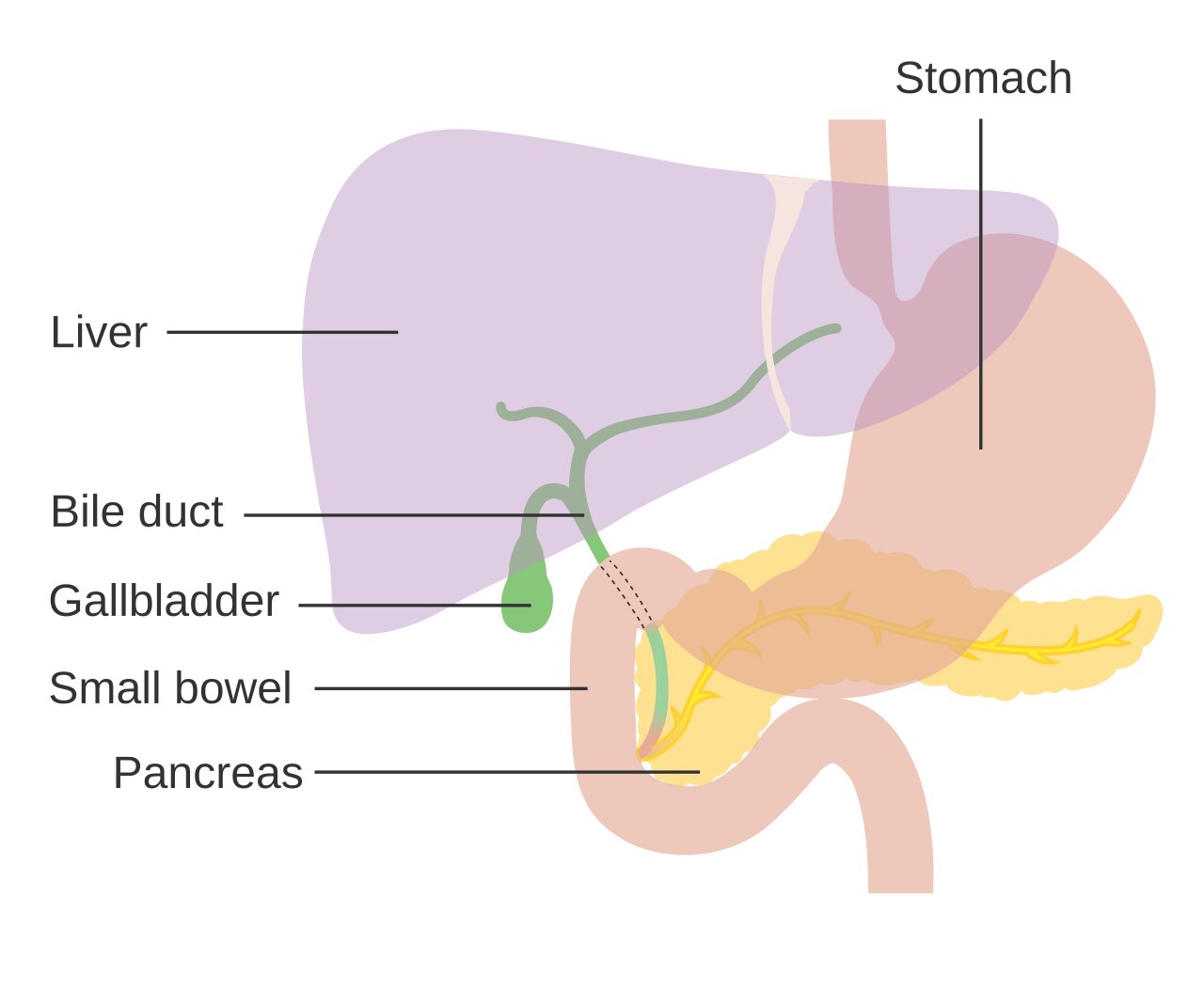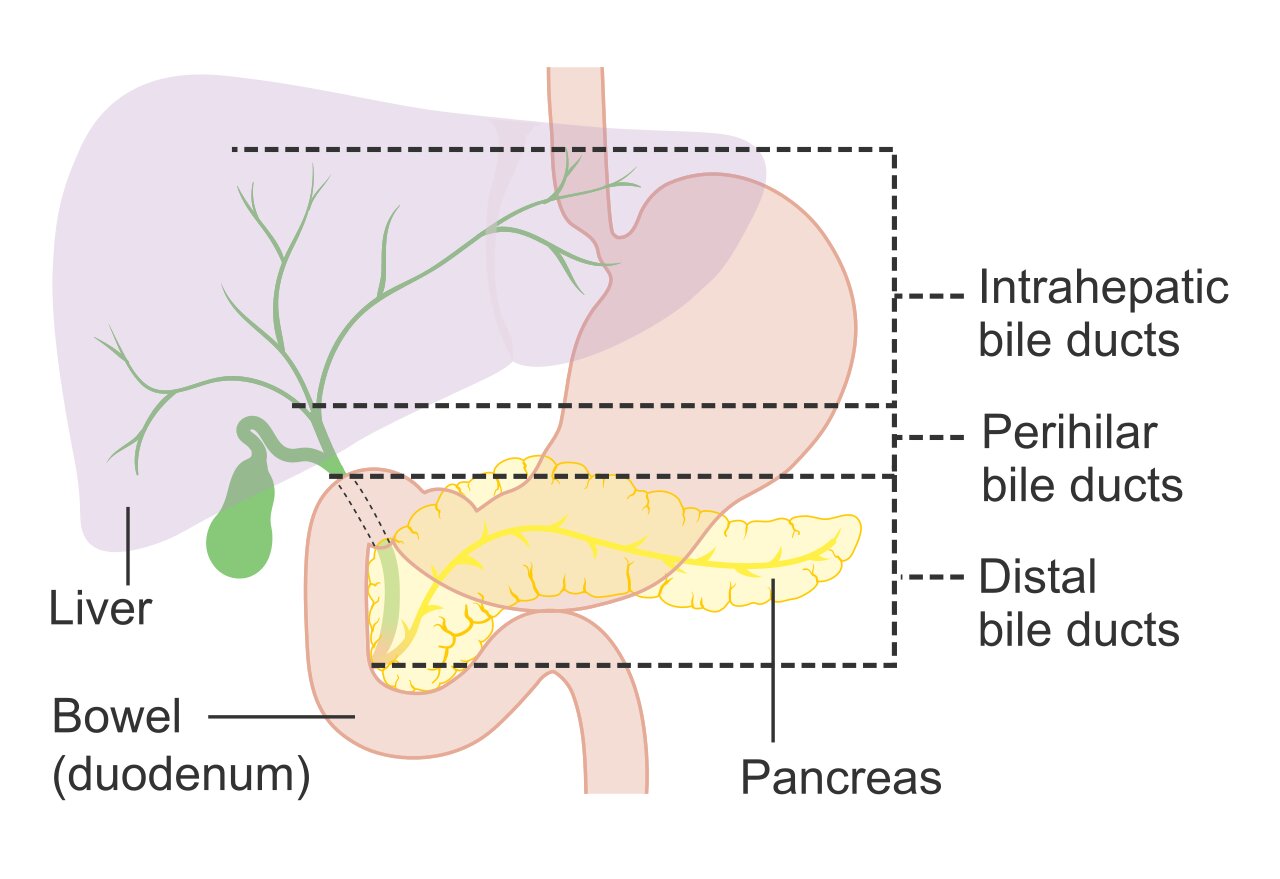Bile Duct Cancer
- Bile duct cancer may be a rare disease during which malignant (cancer) cells form within the bile ducts.
- Having colitis or certain liver diseases can increase the risk of common bile duct cancer.
- Signs of bile duct cancer include jaundice and pain within the abdomen.
- Tests that examine the bile ducts and nearby organs are used to diagnose and stage bile duct cancer.
- Different procedures could also be used to obtain a sample of tissue and diagnose bile duct cancer.
- Certain factors affect prognosis (chance of recovery) and treatment options

Bile duct cancer is a rare disease in which malignant (cancer) cells form in the bile ducts.
A network of tubes, called ducts, connects the liver, gallbladder, and little intestine. This network begins within the liver where many small ducts collect bile (a fluid made by the liver to interrupt down fats during digestion). The tiny ducts close to making the right and left hepatic ducts, which lead out of the liver. The 2 ducts join outside the liver and form the common hepatic duct. The cystic duct connects the gallbladder to the common hepatic duct. Bile from the liver passes through the hepatic ducts, common hepatic duct, and cystic duct and is stored within the gallbladder. When food is being digested, bile stored within the gallbladder is released and passes through the cystic duct to the common bile duct and into the tiny intestine. Bile duct cancer is additionally called cholangiocarcinoma.

Signs of bile duct cancer include jaundice and pain in the abdomen.
These and other signs and symptoms could also be caused by bile duct cancer or by other conditions. Ask your doctor if you've got any of the following:
- Jaundice (yellowing of the skin or whites of the eyes).
- Dark urine
- Clay-colored stool
- Pain within the abdomen.
- Fever
- Itchy skin
- Nausea and vomiting
- Weight loss for an unknown reason.
Tests that examine the bile ducts and nearby organs are used to diagnose and stage bile duct cancer.
Procedures that make pictures of the bile ducts and therefore the nearby area help diagnose bile duct cancer and show how far cancer has spread. The method used to determine if cancer cells have spread within and around the bile ducts or to distant parts of the body is named staging. To plan treatment, it's important to know if the bile duct cancer is often removed by surgery. Tests and procedures to detect, diagnose, and stage bile duct cancer are usually done at an equivalent time.
The following tests and procedures could also be used:
- Physical exam and health history: An exam of the body to check general signs of health, including checking for signs of disease, such as lumps or anything else that seems unusual. A history of the patient’s health habits and past illnesses and treatments also will be taken.
- Liver function tests: A procedure during which a blood sample is checked to measure the amounts of bilirubin and alkaline phosphatase released into the blood by the liver. a higher than normal amount of those substances is often a symbol of liver disease which will be caused by bile duct cancer.
- Laboratory tests: Medical procedures that test samples of tissue, blood, urine, or other substances within the body. These tests help to diagnose disease, plan and check treatment, or monitor the disease over time
- Carcinoembryonic antigen (CEA) and CA 19-9 tumor marker test: A procedure during which a sample of blood, urine, or tissue is checked to measure the amounts of certain substances made by organs, tissues, or tumor cells within the body. Certain substances are linked to specific types of cancer when found in increased levels within the body. These are called tumor markers. Higher than normal levels of carcinoembryonic antigen (CEA) and CA 19-9 may mean there's bile duct cancer.
- Ultrasound exam: A procedure during which high-energy sound waves (ultrasound) are bounced off internal tissues or organs, like the abdomen, and make echoes. The echoes form an image of body tissues called a sonogram. The image is often printed to be checked out later.
- CT scan (CAT scan): A procedure that creates a series of detailed pictures of areas inside the body, like the abdomen, taken from different angles. The photographs are made by a computer linked to an x-ray machine. A dye could also be injected into a vein or swallowed to assist the organs or tissues show up more clearly. This procedure is additionally called computed tomography, computerized tomography, or computerized axial tomography.
- MRI (magnetic resonance imaging): A procedure that uses a magnet, radio waves, and a computer to form a series of detailed pictures of areas inside the body. This procedure is additionally called nuclear magnetic resonance imaging (NMRI).
- MRCP (magnetic resonance cholangiopancreatography): A procedure that uses a magnet, radio waves, and a computer to form a series of detailed pictures of areas inside the body like the liver, bile ducts, gallbladder, pancreas, and pancreatic duct.

Certain factors affect prognosis (chance of recovery) and treatment options.
The prognosis and treatment options depend upon the following:
- Whether the cancer is within the upper or lower part of the bile duct system.
- The stage of cancer (whether it affects only the bile ducts or has spread to the liver, lymph nodes, or other places within the body).
- Whether cancer has spread to nearby nerves or veins
- Whether cancer is often completely removed by surgery.
- Whether the patient has other conditions, like primary sclerosing cholangitis
- Whether the level of CA 19-9 is higher than normal
- Whether cancer has just been diagnosed or has recurred (come back).
Treatment options may also depend upon the symptoms caused by cancer. bile duct cancer is typically found after it has spread and may rarely be completely removed by surgery. Palliative therapy may relieve symptoms and improve the patient's quality of life.
Stages of Bile Duct Cancer
KEY POINTS
- The results of diagnostic and staging tests are used to find out if cancer cells have spread.
- There are three ways that cancer spreads in the body.
- Cancer may spread from where it began to other parts of the body.
- Stages are used to describe the different types of bile duct cancer.
- Intrahepatic bile duct cancer
- Perihilar bile duct cancer
- Distal bile duct cancer
- The following groups are used to plan treatment:
- Resectable (localized) bile duct cancer
- Unresectable (including metastatic and recurrent) bile duct cancer
Treatment options may also depend upon the symptoms caused by cancer. bile duct cancer is typically found after it has spread and may rarely be completely removed by surgery. Palliative therapy may relieve symptoms and improve the patient's quality of life.
The results of diagnostic and staging tests are used to find out if cancer cells have spread.
The process used to determine if cancer has spread to other parts of the body is named staging. For bile duct cancer, the knowledge gathered from tests and procedures is used to plan treatment, including whether the tumor can be removed by surgery.
There are three ways that cancer spreads in the body.
Cancer can spread through tissue, the lymph system, and therefore the blood:
- Tissue. Cancer spreads from where it began by growing into nearby areas
- Lymph system. Cancer spreads from where it began by stepping into the lymph system. Cancer travels through the lymph vessels to other parts of the body.
- Blood. Cancer spreads from where it began by stepping into the blood. Cancer travels through the blood vessels to other parts of the body
Cancer may spread from where it began to other parts of the body.
When cancer spreads to a different part of the body, it is called metastasis. Cancer cells break away from where they began (the primary tumor) and travel through the lymph system or blood.
- Lymph system. Cancer gets into the lymph system, travels through the lymph vessels, and forms a tumor (metastatic tumor) in another part of the body.
- Blood. Cancer gets into the blood, travels through the blood vessels, and forms a tumor (metastatic tumor) in another part of the body.
The metastatic tumor is that the same sort of cancer because of the primary tumor. for instance, if bile duct cancer spreads to the liver, the cancer cells in the liver are bile duct cancer cells. The disease is metastatic bile duct cancer, not liver cancer.
OneSmarterHealth is a pre-eminent cancer portal which helps you to connect with the best cancer consultants from the top 10 cancer hospitals in the USA. By clicking directly, you will get a second opinion and online consultation from the reputed oncologists in the USA.
So, what are you waiting for? Visit the website of OneSmarterHealth and connect with them for a second opinion from an US-based doctor. Your one simple step can bring a smile to your loved ones.
